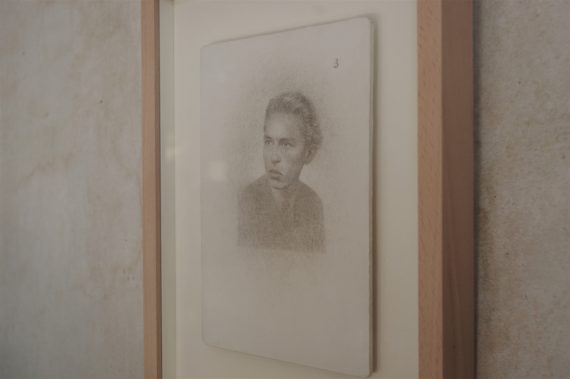I’m very pleased to find that my drawing, ‘Displaced Portrait No15 (woman with baby)’ will be included in the Turner Contemporary Open exhibition later this year.
This piece is one of an ongoing series of silverpoint drawings based on souvenir and identity photographs taken mostly in Germany in the 1930s and 1940s and which I have found at different times in the same second-hand shop in Margate (my home town). The original photograph is a snapshot-trace of the look of a moment. My drawings are a kind of meditation on these displaced traces of moments in lives.
There are any number of reasons why a person’s image might find its way into a second-hand shop. I know nothing about this particular woman or the baby. But I can assume that she was German because she appears in another photograph, dated to New Year 1940, in which she is part of a happy-looking family group which includes men dressed in Wehrmacht uniforms.
My drawings take time. They emerge over the course of months, and sometimes years, of painstaking rounds of re-drawing. They are repeatedly scratched-away and redrawn with points of silver, needles, scalpel blades and sandpaper. Each re-working is a chance to see something new. My drawings are never just hand-made copies of photographs. Through repeated redrawing, I hope to bring something to the surface which I could not have foreseen.
I wonder who have I drawn here?
The ‘Turner Contemporary Open’ runs from October 2021 until February 2022.
One of my drawings has made it through to the second stage of the selection process for the 2021 Trinity Buoy Wharf Drawing Prize.
‘Displaced Portrait No16 (woman from Brünn/Brno, 1942)’ is one of an ongoing series of silverpoint drawings based on portrait photographs taken mostly in Germany in the 1930s and 1940s and which have found their way into my hands via a second-hand shop in my home town, Margate (U.K.). MY drawings are a kind of meditation on these displaced traces of lived moments.
This particular drawing is of a woman who, judging from the hand-writing on the back of the photograph, was a German-speaker living in Brünn in 1942 in what is now the Czech Republic. Brünn is nowadays called Brno. At the end of the war the ethnically German population was expelled.
The medium is silverpoint on gesso on board (21cm x 15cm). The piece has been repeatedly drawn onto with points of silver wire, drawn into with needles, and scratched-away with scalpel blades and sandpaper. The image goes through a process of repeated loss and re-finding. With each re-working, certain details change; but always the repeated point of reference is the original photographic image. I draw in the hope of catching sight of something which I could not have foreseen but which feels somehow true. These drawings are worked on over the course of months and years. They often never reach an end-point.
My drawing pays attention to a displaced souvenir from the past. Each re-working points to the same thing but each re-working is also a different drawing. Whatever it is that I’m trying to see seems always to be elusive.
Hand-made drawings remind us that there is always another way of seeing and that there is always another way to mark those moments of recognition. I wonder who I have drawn here.
The selectors for this year’s Trinity Buoy Wharf Drawing Prize are the artist Sheela Gowda, Simon Groom (Director of Modern and Contemporary Art, National Galleries of Scotland) and Zoé Whitley (Director of Chisenhale Gallery).
You can find more about this body of work on my other Drawing, ‘Roy Eastland: Drawing’ and on my youtube channel.
Fingers crossed!


